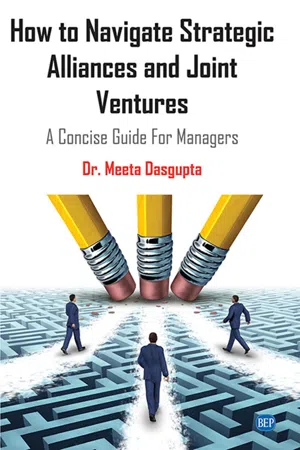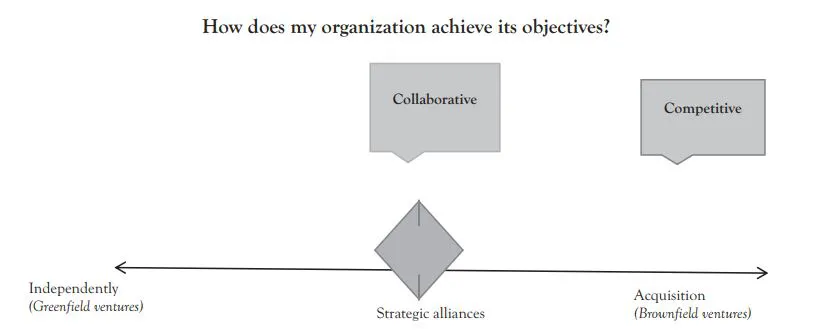![]()
CHAPTER 1
What Are Strategic Alliances?
Do You Expect to Conquer the World Independently?
Over the past number of years, both domestic and international strategic alliances have grown exponentially in number and are now a very popular instrument in the current competitive global environment. Many multinational organizations that had previously shunned alliances are becoming increasingly involved in partnerships. Organizations have realized the importance of strategic alliances as a means of complementing their generic competitive strategies. Organizations have realized that it is challenging to take on the world by oneself. They have realized that they can no longer develop all the resources, technologies, and products to compete in the current dynamic marketplace. Strategic alliances, becoming a critical part of the overall strategy of the organization, are being used to develop critical skills, knowledge, and capabilities that it lacks and to grow product and service offerings. The make versus buy decision, which once confronted decision makers, has expanded and has become more complex—make versus buy versus partner decision. This argument is supported by a study conducted by Accenture, which reported that about 25 percent of the executives said alliances accounted for at least 15 percent of their market value. A study conducted by KPMG professionals in 2017, wherein they surveyed around 50 alliance experts from around the world, supports the importance organizations give to strategic alliances in their overall corporate strategy. Figure 1.1 graphically exhibits the opinion voiced by the experts in the study.
Figure 1.1 Importance of strategic alliances in overall corporate strategy
IBM’s entry into the personal computer industry was greatly facilitated by its willingness to rely on outsiders for development and production: Intel for chips, Microsoft for operating systems software, Epson for peripherals, and a number of Asian vendors for other components. General Motors partners include Isuzo, Suzuki, and Toyota. While taking the example of Tata Motors, some 100 component makers worked with the organization for over three years to create Nano. Ratan Tata was able to keep his promise and deliver a car for INR 100,000, the Nano with help from them, most of them homespun Indian outfits. This exemplifies the fact that organizations, big and small, are accepting the importance of alliances to compete and win at the global level. It is clear that strategic alliances as an organizational structure for global organizations have become very popular.
A very big contributor toward this partnership drive has been the emergence of global integration. Global integration can be looked through the lens of globalization of demand, globalization of supply, globalization of competition, and globalization of strategy. Demand from customers is not restricted to a particular geography. Their tastes have become global, their preferences becoming standardized, thereby leading to the evolution of a global marketplace. The concept of supply globalization works in tandem to the House of Innovation proposed by C.K. Prahalad in his book New Age of Innovation, wherein an organization, in order to satisfy one customer, needs to have access to unlimited resources. Companies also, in their drive toward cost efficiency, have diversified their supply chain management activities across the globe. This makes it imperative for them to tie up with the local players of different geographies. Apple’s iPhone has its various parts manufactured by suppliers in China, Japan, and Taiwan. Competition has become global. Gone are the days when organizations would compete with local players. It is a global battlefield with global corporate stalwarts pitted against each other. Tata Motors is not only competing against the likes of Maruti Suzuki and Mahindra and Mahindra, but due to acquisition of Jaguar Land Rover also with luxury carmakers. The strategic choices that organizations have to make or the decisions they have to take also have taken a global perspective. A change in the business scenario anywhere in the world might impact an organization’s decisions.
Changing Dynamics of the World
Not only has the importance of strategic alliances picked up, but the dynamics have also changed. Triadization or strategic alliances among the triad regions of North America, Western Europe, and Japan has given way to alliances with the big emerging market countries of India, China, Brazil, Indonesia, and others. Examples are as follows:
- Walmart making an inroad into the Indian retail industry by entering into a joint venture with Bharti Enterprises.
- Fiat entering into a strategic alliance with Tata Motors for joint production of cars and distribution of Fiat cars.
- Cafe Coffee Day tying up with Swiggy, an online food delivery startup, to deliver coffee and snacking items at the doorstep.
- Spotify getting into an alliance with Uber to provide stereo control and personalized experience to Uber riders.
Multinationals, realizing the importance of the emerging markets, have changed their focus to entering into collaborations with Indian companies.
Need for an Organization to Enter
Into a Strategic Alliance
Executives of every organization planning to grow and achieve certain strategic outcomes are posed with this question sooner or later during their lifespan.
The decisions can be shown across a continuum, as illustrated in Figure 1.2.
Figure 1.2 Choices for an organization
An organization has a choice; to achieve its objectives independently, also referred to as organic growth, to go and acquire another organization, or enter into collaboration with another; the latter two choices also referred to as inorganic growth. In the first case, the organization should have the resources and capabilities that would help it to achieve its objectives independently. In case the organization lacks the resources and capabilities to develop those resources independently, it can go and acquire another organization that has all the resources and capabilities the organization lacks. But, the organization should be prepared to own the complete risks and liabilities of the acquired organization. In case that is not something that the organization is prepared for, it can consider entering into a collaboration. Decision of a strategic alliance lies somewhere in between on the continuum.
For successful implementation of a global strategy, it becomes essential that a multinational enterprise should carefully implement its entry strategy for each international market because the success or failure of investment in one market will critically influence the activities in the complete network.
According to the real options theory, strategic alliances confer valuable options to expand or grow under conditions of uncertainty. By entering into strategic alliances, organizations are able to limit their downside losses to an initial, limited commitment, as well as position itself to expand. Organizations can spur their growth or market entry strategies either through greenfield investments or through mergers and acquisitions. In capital and research-intensive industries, organizations can spread risk over multiple capital providers by engaging in international joint ventures, rather than outright acquisitions. By entering into international strategic alliances, multinational corporations (MNCs) can also rely upon local partners’ resources to manage risk, including their local knowledge, relationships with local government, and so forth. International strategic alliances lead to higher value creation, particularly in the presence of asymmetric information between the partners.
Strategic alliances help to increase efficiency. Cooperation leads to increased output, lower prices, and creation of new or better products. Two underlying sources of efficiencies are reduced costs and increased investment incentives. Production and distribution costs are reduced by realizing potential scope and scale economies and by eliminating duplicative activities. Increased technological rivalry stimulates innovation. Research and development (R&D) activities when done in coordination would not only speed up the development of new products at lower cost, but also help to achieve scale economies through joint ownership of a single large production facility.
Many international strategic alliances in developing countries are driven with the aim to grow, with research showing that the growth potential in case of emerging economies’ alliances was more than that of developed economies’ alliances. Organizations in industries with high technology components such as electronics, computers, and chemicals tend to have greater growth option values than those in food processing or tire manufacturing industries. International strategic alliances provide access to foreign markets, which otherwise would have been difficult to ...


